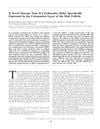 139 citations
,
December 1998 in “The journal of investigative dermatology/Journal of investigative dermatology”
139 citations
,
December 1998 in “The journal of investigative dermatology/Journal of investigative dermatology” K6hf is a unique protein found only in a specific layer of hair follicles.
79 citations
,
October 1998 in “Genomics” The study reported on the cloning and characterization of two functional keratin 6 (K6) genes in mice, mK6alpha and mK6beta, which were found to be organized in tandem and differentially regulated at the mRNA level in various stratified epithelia. The research suggested that these mouse K6 genes evolved independently from their human counterparts after species divergence. The mK6alpha isoform was predominantly expressed in the outer root sheath of hair follicles in intact trunk skin of adult mice. Both mK6alpha and mK6beta mRNAs were rapidly induced in the epidermis and proximal hair follicles following acute injury or phorbol ester application, although they exhibited different induction kinetics. These findings provided insights into the evolution, regulation, and function of K6 genes in mammals.
26 citations
,
February 1998 in “DNA and Cell Biology” The study focused on the keratin 6 (K6) gene, which is important in hair follicles and certain epithelial tissues, particularly under hyperproliferative conditions. Researchers analyzed a 9 kbp region of the K6 gene in transgenic mice to understand the sequences controlling its expression. They found that K6 expression required cooperation between distal and proximal elements, with inducible expression under hyperproliferative conditions linked to a 2.4 kbp fragment before the transcription start site. This complex regulatory organization suggested that K6 expression could be manipulated in transgenic mouse models for studying epidermal disorders, allowing targeted gene expression in response to specific stimuli.
44 citations
,
May 1997 in “Journal of Biological Chemistry” The study investigated the regulatory sequences of the human keratin 6a (K6a) gene responsible for inducible expression in stratified epithelia following injury. Using transgenic mice, researchers found that the proximal 960 base pairs of the 5'-upstream sequence of the K6a gene were sufficient to induce beta-galactosidase expression in response to epidermal injury and chemical treatments known to induce K6 expression. The critical regulatory sequences for this inducibility were located between -960 and -550 base pairs, with enhancer elements influencing activity found between -2500 and -5200 base pairs. These findings highlighted the specific genetic elements involved in the gene expression response to epithelial injury.
232 citations
,
July 1995 in “Nature Genetics” 46 citations
,
May 1995 in “Proceedings of the National Academy of Sciences” The study investigated the regulatory sequences of the bovine keratin 6 gene, which is known for its complex expression pattern in hair follicles and various stratified epithelia, and its induction during hyperproliferative conditions. Researchers used transgenic mice to test different parts of the keratin 6 gene linked to a beta-galactosidase reporter gene. They found that a 9-kbp fragment from the 5' upstream region could drive both tissue-specific and inducible expression, suggesting its potential use in gene therapy for epidermal hyperproliferative disorders.
55 citations
,
May 1995 in “The journal of investigative dermatology/Journal of investigative dermatology” 187 citations
,
May 1988 in “Differentiation” 248 citations
,
April 1988 in “Differentiation” 135 citations
,
November 1987 in “Differentiation” 116 citations
,
April 1986 in “The journal of cell biology/The Journal of cell biology” Trichohyalin is a protein in hair follicles that helps form hair filaments.
292 citations
,
October 1985 in “The Journal of Cell Biology”
